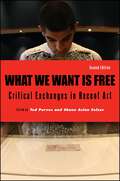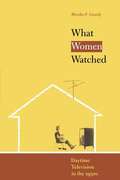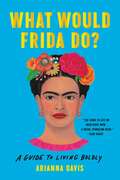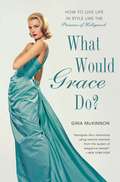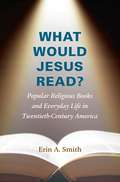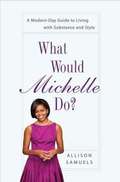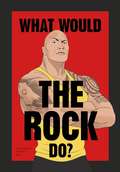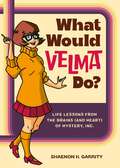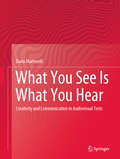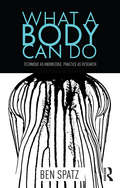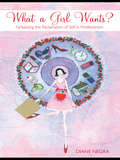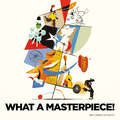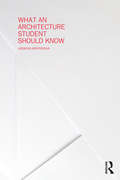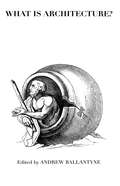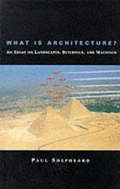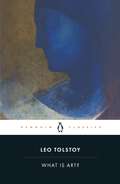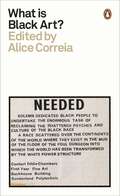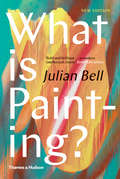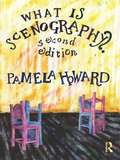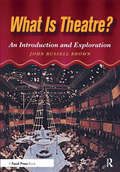- Table View
- List View
What We Want Is Free, Second Edition: Critical Exchanges in Recent Art
by Ted Purves; Shane Aslan SelzerThis revised edition of What We Want Is Free examines a twenty-year history of artistic productions that both model and occupy the various forms of exchange within contemporary society. From shops, gifts, and dinner parties to contract labor and petty theft, contemporary artists have used a variety of methods that both connect participants to tangible goods and services and, at the same time, offer critiques of and alternatives to global capitalism and other forms of social interaction. Examples of these various projects include the creation of free commuter bus lines and medicinal plant gardens, the distribution of such services as free housework or computer programming, and the production of community media projects such as free commuter newspapers and democratic low-wattage radio stations.Like the first edition, the second edition includes a detailed survey of artists' projects from around the globe, as well as critical essays and artists' texts that explore the underlying social history and contemporary issues that further inform our reading of these works. This new edition also features a new introduction and additional chapters on the relation of exchange practices to democracy, the commons, object-oriented philosophy, and an examination of the impact of ongoing globalization on the economics of artists' projects. It also features a significantly expanded scope for the project histories, including work from the past decade and a new section dedicated to artist-initiated organizations and innovative models for new institutions.
What Were the Twin Towers? (What Was?)
by Jim O'Connor Ted Hammond Kevin McveighDiscover the true story of the Twin Towers--how they came to be the tallest buildings in the world and why they were destroyed.When the Twin Towers were built in 1973, they were billed as an architectural wonder. At 1,368 feet, they clocked in as the tallest buildings in the world and changed the New York City skyline dramatically. Offices and corporations moved into the towers--also known as the World Trade Center--and the buildings were seen as the economic hub of the world. But on September 11, 2001, a terrorist attack toppled the towers and changed our nation forever. Discover the whole story of the Twin Towers--from their ambitious construction to their tragic end.
What Will These Hands Make?
by Nikki McClure“Themes of community, creativity, and craft are at the heart of this book about a family preparing for a grandmother’s birthday celebration.” —School Library JournalThis lyrical picture book from beloved creator Nikki McClure follows a family through one day and muses in the possibilities that one day holds—from enjoying treats at the bakery, to admiring handmade goods from local artisan shops, to observing the new construction in town. Illuminating themes of community, creativity, and collaboration, What Will These Hands Make? dares the reader to dream up everything they can be and all the ways they can leave their little corner of the world better than they found it.“Capitalized headers boldly ask “WILL THESE HANDS MAKE,” with possibilities unfurling in lyrical, lucid verse beneath. Awe-inspiring double-page spreads show a busy town from multiple, miraculous perspectives . . . Extraordinary artwork inspires young people to use their hearts and hands.” —Kirkus Reviews (starred review)“This celebration of citizenry and craft is a poignant reminder of the objects and places that makers weave . . . The book’s appeal spans a wide range: younger readers will enjoy the seek-and-find aspect, and older readers may find inspiration in its vision of daily life and communal innovation.” —Publishers Weekly (starred review)“Careful viewers will be delighted to find scenes revisited in closer detail and from different vantage points . . . The clever bookmaking technique, which moves between the busy scene and its individual sections, produces the joy of a shared experience in which all hands combine.” —Booklist
What Women Watched: Daytime Television in the 1950s
by Marsha F. CassidyIn this pathfinding book, based on original archival research, Marsha F. Cassidy offers the first thorough analysis of daytime television's earliest and most significant women's genres, appraising from a feminist perspective what women watched before soap opera rose to prominence.
What Would Frida Do?: A Guide to Living Boldly
by Arianna DavisA contemporary guide to life, love, and happiness inspired by the extraordinary artist Frida Kahlo.Revered as much for her fierce spirit as she is for her art, Frida Kahlo stands today as a brazen symbol of daring creativity. She was a woman ahead of her time whose paintings have earned her generations of admirers around the globe. But perhaps her greatest work of art was her own life.What Would Frida Do? explores the feminist icon's signature style, outspoken politics, and boldness in love and art, even in the face of pain and heartbreak. The book celebrates her larger than life persona as a woman who loved passionately and lived ambitiously, refusing to remain in her husband's shadow. Each chapter shares intimate stories from her life, revealing how she overcame obstacles by embracing her own ideals.In this charming read, author Arianna Davis conjures Frida's brave spirit, encouraging women to persevere, to create fearlessly, and to stand by their own truths.
What Would Grace Do?
by Gina Mckinnon Penelope BeechFind your inner Grace: A modern day guide to the classic beauty and timeless style of the Hollywood starlet and real-life Princess, Grace Kelly Grace Kelly set a standard for elegance that continues to inspire women today--particularly in our Mad Men-crazed era. More than merely blessed with camera-wooing beauty, Princess Grace was also a canny decision maker who selected roles that quickly made her one of cinema's most adored and unforgettable leading ladies. She also captured hearts on- and off-camera, including many belonging to her handsome co-stars. Though her reign as Princess of Hollywood yielded all-too-soon to her real-life role as Princess of Monaco, Grace Kelly remains the timeless embodiment of refined glamour, style, and poise. Now, Gina McKinnon makes Grace Kelly's indelible style secrets available to everyone. In What Would Grace Do?, readers will find invaluable lessons in charm and loveliness--from handling careers and cashmere to manners and men. In the style of What Would Jackie Do? and What Would Audrey Do? comes a beautifully designed book filled with lovely two-color illustrations. What Would Grace Do? inspires women everywhere to reach for those moments of strife when we could all use a little Grace.
What Would Jesus Do?
by Garrett W. SheldonA smart young pastor. A friendly, growing congregation. Great music. Stirring worship services. And, of course, a host of expanding church programs. It felt comfortable, and it looked perfect - until the day a younghomeless woman cried out for help. Spurred by her tragic plea, Ashton suddenly comes face to face with perhaps the ultimate question for any Christian - what would Jesus do? What would He do at a college, the airport and the local TV station? How would He leat at home and at church? How would He behlp the homeless and other people in need? Soon, a small band of believers pledges to walk "as Jesus would" for one year - and see how God moves in their homes, their church and their community. You can imagine the difference it made in their lives. And better yet, you can learn the difference it can make in yours.
What Would Jesus Read?
by Erin A. SmithSince the late nineteenth century, religiously themed books in America have been commercially popular yet scorned by critics. Working at the intersection of literary history, lived religion, and consumer culture, Erin A. Smith considers the largely unexplored world of popular religious books, examining the apparent tension between economic and religious imperatives for authors, publishers, and readers. Smith argues that this literature served as a form of extra-ecclesiastical ministry and credits the popularity and longevity of religious books to their day-to-day usefulness rather than their theological correctness or aesthetic quality.Drawing on publishers' records, letters by readers to authors, promotional materials, and interviews with contemporary religious-reading groups, Smith offers a comprehensive study that finds surprising overlap across the religious spectrum--Protestant, Catholic, and Jewish, liberal and conservative. Smith tells the story of how authors, publishers, and readers reconciled these books' dual function as best-selling consumer goods and spiritually edifying literature. What Would Jesus Read? will be of interest to literary and cultural historians, students in the field of print culture, and scholars of religious studies.
What Would Michelle Do?
by Allison SamuelsAn inspiring life and style guide for every woman who admires the popular and poised First Lady Michelle Obama Embodying style, class, and intelligence, Michelle Obama has quickly become an American icon. Yet, she still faces the same issues as most women today. As they watch her juggle kids, marriage, and a seemingly nonstop calendar without breaking a sweat, American women are asking, What Would Michelle Do? Award-winning Newsweek journalist Allison Samuels, who has interviewed the First Lady numerous times, follows the trajectory of Michelle's life to illustrate the determination, intellect, and charm that drive her success-and reveals how women can incorporate those same attributes to get everything Michelle has, from her toned arms to her grace under pressure to her happy marriage. Covering a range of lifestyle topics-from creating a distinctive style to conquering obstacles to managing a household-What Would Michelle Do? combines solid advice with a fun package that will appeal to style mavens, soccer moms, and career women alike.
What Would The Rock Do?: Uplifting Advice From The Nicest Guy In Rock And Roll
by Pop Press'Can you smell what The Rock is cooking?!' He has yet to encounter an obstacle he couldn't overcome. He's the WWE legend as eight-time champion, he's outlasted being buried up to his neck in a desert (The Scorpion King), battled the giant Tamatoa (Moana), ruthless mercenaries (Jumanji), and murderous racers (the Fast and Furious series) all thanks to his motivation and drive.Do you want to learn how to do the same? Then get inspired with this uplifting collection of quotes from the man himself on success, wrestling, fitness, family and more.What else can we say, except, you're welcome?!
What Would Velma Do?: Life Lessons from the Brains (and Heart) of Mystery, Inc.
by Shaenon K. GarrityA clever illustrated ode to the breakout star of Scooby-Doo, exploring the life lessons this iconic nerd girl teaches us and why we should all aim to be the Velma of our friend group From the moment Scooby-Doo, Where Are You! premiered in 1969 and through the many Scooby movies and shows since, it has cemented its place as one of the greatest cartoons of all time. But there is one character in particular who has risen to icon status: a smarty-pants who can't see without her glasses named Velma Dinkley. As the nerdiest member of the Mystery, Inc. gang, Velma might have been a wallflower or an underdog. Instead, she's become a fan favorite, a fashion legend, a standout role for Linda Cardellini in the live-action movies, the inspiration for countless Halloween costumes, and the star of her own animated series from Mindy Kaling. But why, exactly, do we love this brainiac so much? What Would Velma Do? explores the answers to that question, as well as the many inspiring takeaways we can learn from her, the history of the character, and enough fun facts and trivia to make you say Jinkies!
What You Become in Flight: A Memoir
by Ellen O'Connell WhittetA lyrical and meditative memoir on the damage we inflict in the pursuit of perfection, the pain of losing our dreams, and the power of letting go of both.With a promising career in classical ballet ahead of her, Ellen O'Connell Whittet was devastated when a misstep in rehearsal caused a career-ending injury. Ballet was the love of her life. She lived for her moments under the glare of the stage-lights--gliding through the air, pretending however fleetingly to effortlessly defy gravity.Yet with a debilitating injury forcing her to reconsider her future, she also began to reconsider what she had taken for granted in her past. Beneath every perfect arabesque was a foot, disfigured by pointe shoes, stuffed--taped and bleeding--into a pink, silk slipper. Behind her ballerina's body was a young girl starving herself into a fragile collection of limbs. Within her love of ballet was a hatred of herself for struggling to achieve the perfection it demanded of her. In this raw and redemptive debut memoir, Ellen O'Connell Whittet explores the silent suffering of the ballerina--and finds it emblematic of the violence that women quietly shoulder every day. For O'Connell Whittet, letting go of one meant confronting the other--only then was it possible to truly take flight.
What You See Is What You Hear: Creativity and Communication in Audiovisual Texts
by Dario MartinelliWhat You See Is What You Hear develops a unique model of analysis that helps students and advanced scholars alike to look at audiovisual texts from a fresh perspective. Adopting an engaging writing style, the author draws an accessible picture of the field, offering several analytical tools, historical background, and numerous case studies. Divided into five main sections, the monograph covers problems of definitions, history, and most of all analysis. The first part raises the main problems related to audiovisuality, including taxonomical and historical questions. The second part provides the bases for the understanding of audiovisual creative communication as a whole, introducing a novel theoretical model for its analysis. The next three part focus elaborate on the model in all its constituents and with plenty of case studies taken from the field of cinema, TV, music videos, advertising and other forms of audiovisuality. Methodologically, the book is informed by different paradigms of film and media studies, multimodality studies, structuralism, narratology, “auteur theory” in the broad sense, communication studies, semiotics, and the so-called “Numanities.” What You See Is What You Hear enables readers to better understand how to analyze the structure and content of diverse audiovisual texts, to discuss their different idioms, and to approach them with curiosity and critical spirit.
What a Body Can Do
by Ben SpatzIn What a Body Can Do, Ben Spatz develops, for the first time, a rigorous theory of embodied technique as knowledge. He argues that viewing technique as both training and research has much to offer current debates over the role of practice in the university, including the debates around "practice as research." Drawing on critical perspectives from the sociology of knowledge, phenomenology, dance studies, enactive cognition, and other areas, Spatz argues that technique is a major area of historical and ongoing research in physical culture, performing arts, and everyday life.
What a Girl Wants?: Fantasizing the Reclamation of Self in Postfeminism
by Diane NegraFrom domestic goddess to desperate housewife, What a Girl Wants? explores the importance and centrality of postfeminism in contemporary popular culture. Focusing on a diverse range of media forms, including film, TV, advertising and journalism, Diane Negra holds up a mirror to the contemporary female subject who finds herself centralized in commodity culture to a largely unprecedented degree at a time when Hollywood romantic comedies, chick-lit, and female-centred primetime TV dramas all compete for her attention and spending power. The models and anti-role models analyzed in the book include the chick flick heroines of princess films, makeover movies and time travel dramas, celebrity brides and bravura mothers, ‘Runaway Bride’ sensation Jennifer Wilbanks, the sex workers, flight attendants and nannies who maintain such a high profile in postfeminist popular culture, the authors of postfeminist panic literature on dating, marriage and motherhood and the domestic gurus who propound luxury lifestyling as a showcase for the ‘achieved’ female self.
What a Masterpiece!
by Riccardo GuascoIn this wordless picture book, the Western world&’s greatest art is closer than you expect. A boy&’s daily routines bring him face-to-face with Escher&’s winding stairs, Banksy&’s balloon girl, Picasso&’s dancing fauns, and many more familiar sights. Maybe the boy&’s bedroom looks a little like Van Gogh&’s. Maybe that apple looks a bit like Magritte&’s. And maybe another masterpiece is on its way… A celebration of creativity across the centuries, What a Masterpiece! will inspire young artists to find wonder in their everyday lives. An art index after the story helps readers identify the cultural treasures behind the illustrations.
What an Architecture Student Should Know
by Jadwiga KrupinskaIt's not just you. Every architecture student is initially confused by architecture school - an education so different that it doesn't compare to anything else. A student’s joy at being chosen in stiff competition with many other applicants can turn to doubt when he or she struggles to understand the logic of the specific teaching method. Testimony from several schools of design and architecture in different countries indicates that many students feel disoriented and uncertain. This book will help you understand and be aware of: Specific working methods at architecture schools and in the critique process, so you'll feel oriented and confident. How to cope with uncertainty in the design process. How to develop the ability to synthesize the complexity of architecture in terms of function, durability, and beauty. This book is about how architects learn to cope with uncertainty and strive to master complexity. Special attention is given to criticism, which is an essential part of the design process. The author, a recipient of several educational awards, has written this book for architecture students and teachers, to describe how each student can adopt the architect's working method. Key concepts are defined throughout and references at the end of each chapter will point you to further reading so you can delve into topics you find particularly interesting. Jadwiga Krupinska is professor emerita at the School of Architecture of the Royal Institute of Technology (KTH) in Stockholm, Sweden.
What is Architecture?
by Andrew BallantyneArchitecture can influence the way we feel, and can help us along as we go about our lives, or sabotage our habitual ways of doing things. The essays collected here challenge, and help to define a view of architecture which ranges from the minimal domesticity of Diogenes' barrel, to the exuberant experiments of the contemporary avant-garde. There are essays by philosophers, architects and art historians, including Roger Scruton, Bernard Tschumi, Demetri Pophyrios, Kenneth Frampton, Diane Ghirardo and David Goldblatt.
What is Architecture?: An Essay on Landscapes, Buildings, and Machines
by Paul ShepheardBritish architect and critic Paul Shepheard is a fresh new voice in current postmodern debates about the history and meaning of architecture. In this wonderfully unorthodox quasi-novelistic essay, complete with characters and dialogue (but no plot), Shepheard draws a boundary around the subject of architecture, describing its place in art and technology, its place in history, and its place in our lives now. At a time when it is fashionable to say that architecture is everything—from philosophy to science to art to theory—Shepheard boldly and irreverently sets limits to the subject, so that we may talk about architecture for what it is. He takes strong positions, names the causes of the problems, and tells us how bad things are and how they can get better. Along the way he marshals some unlikely but plausible witnesses who testify about the current state of architecture. Instead of the usual claims or complaints by the usual suspects, these observations are of an altogether different order. Constructed as a series of fables, many of them politically incorrect, What is Architecture? is a refreshing meditation on the options, hopes, possibilities, and failures of shelter in society.
What is Art? (Bloomsbury Revelations Ser.)
by Leo TolstoyDuring his decades of world fame as a novelist, Tolstoy also wrote prolifically in a series of essays and polemics on issues of morality, social justice and religion. These works culminated in What is Art?, published in 1898. Impassioned and iconoclastic, this powerfully influential work both criticizes the elitist nature of art in nineteenth-century Western society, and rejects the idea that its sole purpose should be the creation of beauty. The works of Dante, Michelangelo, Shakespeare, Beethoven, Baudelaire and Wagner are all vigorously condemned, as Tolstoy explores what he believes to be the spiritual role of the artist - arguing that true art must work with religion and science as a force for the advancement of mankind.
What is Black Art?
by Alice CorreiaA landmark anthology on British art history, bringing together overlooked and marginalized perspectives from 'the critical decade'What is Black art? This vital anthology gives voice to a generation of artists of African, Asian and Caribbean heritage who worked within and against British art institutions in the 1980s, including Sonia Boyce, Lubaina Himid, Eddie Chambers and Rasheed Araeen. It brings together artists' statements, interviews, exhibition catalogue essays and reviews, most of which have been unavailable for many years and resonate profoundly today. Together they interrogate the term 'Black art' itself, and revive a forgotten dialogue from a time when men and women who had been marginalized made themselves heard within the art world and beyond.
What is Painting? (Revised Edition): New Edition
by Julian BellJulian Bell’s incisive, fully updated study of modern art and the nature of painting, which daringly tries to explain it “Yes, but is it art?” This lucid book by Julian Bell, himself a painter, confronts the uncertainty many people feel about art today and challenges generally accepted ideas. Now in a completely revised second edition, What is Painting? is a fresh, focused look at painting. Bell addresses questions such as “does anything unite those objects we call paintings?” and “what factors have changed the nature of painting over the last two centuries?” by looking at historical evidence and reasoning from common experience. The current shape of painting pushes the book’s arguments in new directions and a substantial new chapter, The Arts and Art, speaks to the interplay between 2D work, 3D work, and the immateriality of digital imagery. The text has been revised paragraph by paragraph considering both force of presentation andr />historical perspective. The intention is to provide a general reader’s introduction to theories of painting that is not only reliably informative but stimulating and amusing to read. The book is an introductory guide to art theory for everyone interested in understanding modern art or in making art themselves.
What is Scenography?
by Pamela Howard"Pamela Howard's ground-breaking What is Scenography? was the first book to set out the bold new approaches to designing and directing for theatre which had dazzled audiences in Europe during the previous decades. It did us all a service by enriching the scope of how we understand the aesthetics of the stage. The lavish new materials (drawings, colour photos, new production analysis) included in this second edition make it even more essential for anyone interested in new developments in theatre." - David Bradby "To write, design, organize, manage, sculpt, educate, paint, research and above all, to passionately live the life of the performance is what Pamela has done throughout her whole career and, in one way or another, it is reflected here in this book: the universality of stage design, its elements and its soul." - Ramon Ivars "Gives an excellent sense of scenography and a window on a life in the theatre - which is fascinating. ...A superb book." - Professor Arnold Aronson, Columbia University, USA "Pamela Howard is the precise definition of what a scenographer of today should be: a multiple artist. Her vast experience with space, her rare and acute power of reflection, her workshops worldwide, her masterful control of drawing and painting and her ability to interconnect scenography with other artistic expressions qualify her to discuss with great authority what "space for staging" should be in the coming decades of this millennium." - Jose Carlos SerroniPamela Howard's What is Scenography? has become a classic text in contemporary theatre design and performance practice. In this second edition, the author expands on her holistic analysis of scenography as comprising space, text, research, art, performers, directors and spectators, to examine the changing nature of scenography in the twenty-first century. The book includes: case studies and anecdotes from Howard's own celebrated career illustrations of her own recent work, in full colour throughout an updated 'world view' of scenography, with definitions from the world's most famous and influential scenographers A direct and personal response to the question of how to define scenography by one of the world's leading practitioners, What is Scenography? continues to shape the work of visual theatremakers throughout the world.
What is Scenography? (Theatre Concepts Ser.)
by Pamela HowardThe third edition of Pamela Howard’s What is Scenography? expands on the author’s holistic analysis of scenography as comprising space, text, research, art, performers, directors and spectators, to examine the changing nature of scenography in the twenty-first century. The book includes new investigations of recent production projects from Howard’s celebrated career, including Carmen and Charlotte: A Tri-Coloured Play with Music, full-colour illustrations of her recent work and updated commentary from a wide spectrum of contemporary theatre makers. This book is suitable for students in Scenography and Theatre Design courses, along with professional theatrical designers.
What is Theatre?: An Introduction and Exploration
by John BrownThis major introductory textbook is from one of the leading educators working in theatre today. What Is Theatre? will make its reader a better playgoer, responding more fully to performance, with a keener appreciation of all the resources of theatre-acting, design, direction, organization, theatre buildings, and audiences. By focusing on the best professional practice and the most helpful learning processes, Dr. Brown shows how to read a play-text and to see and hear its potential for performance. Throughout this book, suggestions are given for student essays and class discussions, to help both instructor and reader to clarify their thoughts on all aspects of theatre-going. While the main focus is on present-day theatre in North America, history is used to illuminate current practice. Theatres in Europe and Asia also feature in the discussion. A view is given of all contributors to performance, with special emphasis placed on actors and the plays they perform. This textbook is not tied to a few specific play-texts, but designed to be effective regardless of which play a student sees or reads. In Part Two, leading practitioners of different generations and cultural backgrounds describe their own work, providing a variety of perspectives on the contemporary theatre. All this is supplemented by nearly 100 black and white and color illustrations from productions, working drawings, and plans. This new text engages its readers in the realities of the theatre; it is up-to-date, comprehensive, and packed with practical advice for understanding how theatre works and how plays come alive in performance. John Russell Brown is professor of Theatre at the University of Michigan, Ann Arbor, and has taught at a variety of colleges including New York and Stanford Universities. For 15 years he was an associate director of the National Theatre in London, and he has directed plays in many other theatres including Cincinnati Playhouse, the Empty Space in Seattle, and the Clurman Theatre in New York. Professor Brown has written extensively about theatre, especially about Shakespeare and contemporary theatre. He is editor of The Oxford Illustrated History of Theatre.
